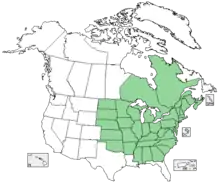| American pennyroyal | |
|---|---|
 | |
| Scientific classification | |
| Kingdom: | Plantae |
| Clade: | Tracheophytes |
| Clade: | Angiosperms |
| Clade: | Eudicots |
| Clade: | Asterids |
| Order: | Lamiales |
| Family: | Lamiaceae |
| Genus: | Hedeoma |
| Species: | H. pulegioides |
| Binomial name | |
| Hedeoma pulegioides | |
 | |
| Distribution map[2] | |
| Synonyms[3] | |
| |
Hedeoma pulegioides, also known as American pennyroyal or American false pennyroyal,[4] is a species of Hedeoma native to eastern North America, from Nova Scotia and southern Ontario west to Minnesota and South Dakota, and south to northern Georgia and Arkansas.[5]
It is a low-growing, strongly aromatic herbaceous annual plant from 15 to 30 cm tall, with a slender erect much-branched, somewhat hairy and square stem. The leaves are small, thin, and rather narrow, with a strong mintlike odor and pungent taste. The flowers are pale blue, monoecious, produced in small clusters; it flowers from mid to late summer.[6]
Other names are mock pennyroyal, squaw mint, tickweed, stinking balm, mosquito plant, American falsepennyroyal, and American false pennyroyal.[6][7]
The term "pennyroyal" (or pennyrile, from a dialectal pronunciation) is also used to describe a geographic province of western Kentucky, the Pennyroyal Plateau, where H. pulegioides grew in profusion sufficient to lend its name to the whole area.
Etymology
The name pulegioides is derived from the Latin pulegium, and means "like pennyroyal", in reference to European pennyroyal (Mentha pulegium).[8] The name pulegium was given to European pennyroyal by Pliny the Elder in the first century CE, for its use in repelling fleas (pulex, plural pulices) when it was spread on floors.[9]
Uses
In the early 20th century, it was used "in domestic medicine, in the form of a warm infusion, to promote perspiration and as an emmenagogue."[10] Upon ingestion, one of its components, pulegone, metabolizes into hepatotoxic metabolites that depending on dosage can lead to organ failure, seizures, and death.[9]
In the 19th century it was recommended for flea control: "Sprigs of wild myrtle, or penny-royal, or small flat camphor-bags dispersed about your under-clothes, and conveniently fastened, will keep fleas from molesting your person during the day. At night, let penny-royal be scattered over the bed-covers, and laid under the pillows and bolster; strewing a large quantity between the sacking and the matrass. Wash yourself before going to bed in water that has had essence of pennyroyal mixed with it."[11]
See also
References
- ↑ "Comprehensive Report Species – Hedeoma pulegioides". NatureServe Explorer: An online encyclopedia of life [web application]. 7.1. Arlington, Virginia: NatureServe Inc. Retrieved 5 January 2014.
- ↑ "Plants profile for Hedeoma pulegioides (American false pennyroyal)". Plants Database. United States Department of Agriculture, Natural Resources Conservation Service. Retrieved 6 January 2014.
- ↑ "Synonyms of American False Pennyroyal (Hedeoma pulegioides)". Encyclopedia of Life. Retrieved 5 January 2014.
- ↑ USDA Plants Profile: Hedeoma pulegioides. Accessed June 19, 2007.
- ↑ "Hedeoma pulegioides". Germplasm Resources Information Network. Agricultural Research Service, United States Department of Agriculture. Retrieved 16 January 2018.
- 1 2 Plants for a Future: Hedeoma pulegioides. Accessed June 19, 2007.
- ↑ NEWCrop USDA Miscellaneous Publication No. 77: The Herb Hunters Guide: American Medicinal Plants of Commercial Importance. NEWCrop's online transcription of the 1930 USDA publication March 11, 1998. Accessed June 19, 2007.
- ↑ Griffith, Chuck. Dictionary of Botanical Epithets. Accessed June 19, 2007.
- 1 2 Trumble, John T. (2002). "Caveat Emptor: Safety Considerations for Natural Products Used in Arthropod Control". American Entomologist. 48 (1): 7–13. doi:10.1093/ae/48.1.7.
- ↑ One or more of the preceding sentences incorporates text from a publication now in the public domain: Reynolds, Francis J., ed. (1921). . Collier's New Encyclopedia. New York: P. F. Collier & Son Company.
- ↑ Leslie, Eliza (1840). The house book, or, A manual of domestic economy: for town and country. Carey & Hart. p. 111. OCLC 432660492.
